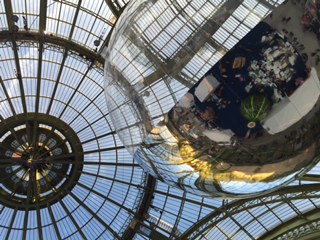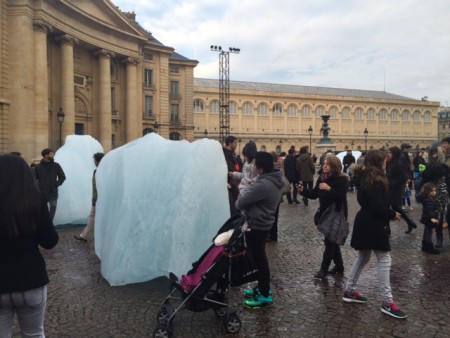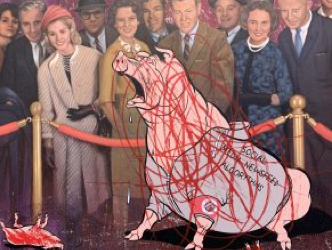The first work is located Place du Panthéon and gathers together twelve large blocks of ice from Greeland. They were originally supposed to be stationed Place de la République. After the November 13 attacks, safety understandably required they be placed elsewhere. The Danish artist of Icelandic origin Olafur Eliasson is responsible for imagining this piece. The principle: Twelve blocks of ice have traveled from a territory that is particularly hit by global warming. The message: The time has come to do something. Now the twelve giant ice cubes are melting under our eyes. Last Sunday there was a dense crowd in front of the piece. Its symbolic meaning is clear. I would not go so far, however, as to speak of a work of art. By playing with symbols, Eliasson acted in favor of a cause by organizing a meaningful event. Usually, his works operate with subtlety through principles of illusion, the confusion of the senses, the play of light and shadow… Here we have a statement but no emotion. Indeed, we are not finding ourselves back in Olafur Eliasson’s highly gripping and subtle universe.
At the same time, among the Grand Palais’ great environmental fair, under the capital’s beautiful, giant glass-and-metal nave, are two balloons by Tomàs Saraceno. You could say that, fundamentally, the work of this Argentina-born, Berlin-based artist is contemplative. It’s easy to imagine him as a child, spending hours observing ants at their tasks and insects crawling through the grass. His world is nature and its usage. Right now, in the Louvre exhibition titled “Brève Histoire de l’Avenir,” whose curator is Palais de Tokyo head Jean de Loisy, he is showing a fascinating sculpture made inside the dark receptacle of a web (net), which a spider is weaving tirelessly. Itself perhaps soon replaced by another eight-legged critter. A work of nature, complete and fascinating, put on the pedestal that befits it. A green readymade.
In the nave of the Grand Palais, Saraceno is showing two huge balloons that he has christened Aerocene, which are propelled not by helium but by a dynamic principle depending on air and heat. Super green. The first solar flight ever undertaken, as he notes on his site. One side is transparent. Another is silver. He stresses the beauty of the reflections on the inflatable structure’s surface. In the video below, the artist says we are floating beings in a floating world. Uh? Yes, that’s what he’s saying. Tomàs Saraceno is a Jules Verne-type artist. Of course, his inflatable structures would be even more beautiful if they were floating by freely in less clouded skies. He does that too.
Support independent news on art.
Your contribution : Make a monthly commitment to support JB Reports or a one off contribution as and when you feel like it. Choose the option that suits you best.
Need to cancel a recurring donation? Please go here.
The donation is considered to be a subscription for a fee set by the donor and for a duration also set by the donor.








